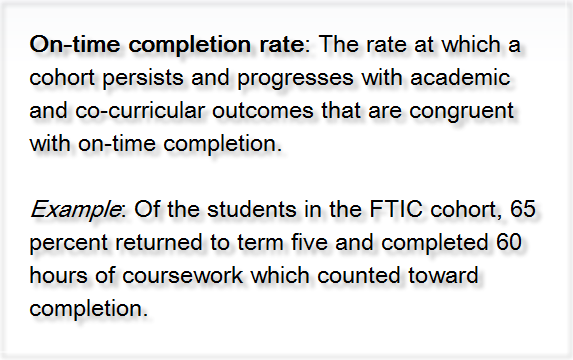enrollment
Shifting focus from retention to on-time completion
This blog post was co-authored by Jennifer Wick, vice president at Scannell & Kurz (an affiliate of Ruffalo Noel Levitz)
Perhaps you have seen our new white paper, Navigating the Student Engagement Stream. On page 8 of this paper, we provide up-to-date definitions and examples of key metrics for student retention and college completion, including this one:

As the national completion agenda grows, there are many colleges, universities and other organizations which are moving us to broaden our thinking, and consequently advise you, on how to plan not only for retention but also for on-time completion. The National Governors Association provides a comprehensive summary of the Common College Completion Metrics nomenclature. Driven by initiatives such as the Scorecard, the Obama administration was developing a College Ratings System, which has recently changed course to providing more consumer information via the College Navigator website. Complete College America describes five game changers that they will help states implement in order to improve on-time completion rates. Traditional graduation metrics defined as 150 percent or greater, of normal time, do not provide a complete picture.
On-time completion and outcomes are becoming the name of the game
The academic experience has always been an integral influence on retention rates, combined with control of entry characteristics (admissions), the student life experience, and overall engagement. However, with the lens now shifting to not just completion, but on-time completion, quality academic advising and curricular pathways that foster successful persistence in courses that count toward the degree plan must come to the fore. Consequently, while it is critical that retention leadership be able to command the respect of both student life and enrollment professionals, it is essential that responsibility for retention reside where there is direct influence on academic support services and faculty. Ideally, effective collaboration exists between all these areas.
Campus example
We recently worked with an institution whose focus was on improving junior year to on-time graduation rates. Through predictive modeling, we were able to identify statistically significant factors for predicting if students were at risk to not graduate on time. Some important variables included whether or not students had ever been on academic probation, had still yet to declare a major, were commuters, or had a more than a certain amount of unmet need (need minus all grants). Individually, none of these factors are a surprise, but viewed collectively and understanding their relative influence, the institution was able to focus resources on the students who could most benefit. Along with “in-time” intervention, this institution is making longer term investments in enhancements to academic advising and reviewing broader institutional policies surrounding resources designed to keep students on track.
What metrics is your campus using to track retention and completion?
There was an active discussion earlier this month of the shifts toward on-time completion metrics at the 2015 National Conference on Student Recruitment, Marketing, and Retention. Participants from two-year and four-year campuses shared a variety of approaches. If you haven’t done so recently, perhaps your campus could ask this question: Of the students in the fall 2014 cohort, what percentage will return in fall 2015 who are on-time for completion? To be honest, this may be a difficult question to answer for many of you. We have been focusing on first year retention rates for so many years. We think the environment of accountability is slowly pushing us to add yearly on-time completion rates to our planning efforts.
For some additional, helpful perspective on retention and completion metrics, check out the 2015 Student Retention Indicators Benchmark Report and our just-released 2015 Student Retention and College Completion Practices Benchmark Report (see the metrics for retention and college completion which are listed among 33 internal operations in the Appendix).
Questions? Want to discuss your approach?
Are conversations on your campus shifting from retention to completion? What action steps have you taken? Please share your experiences by commenting, and if you’re having trouble turning talk into action, please contact us at 800.756.7483, ext. 5602, or email.